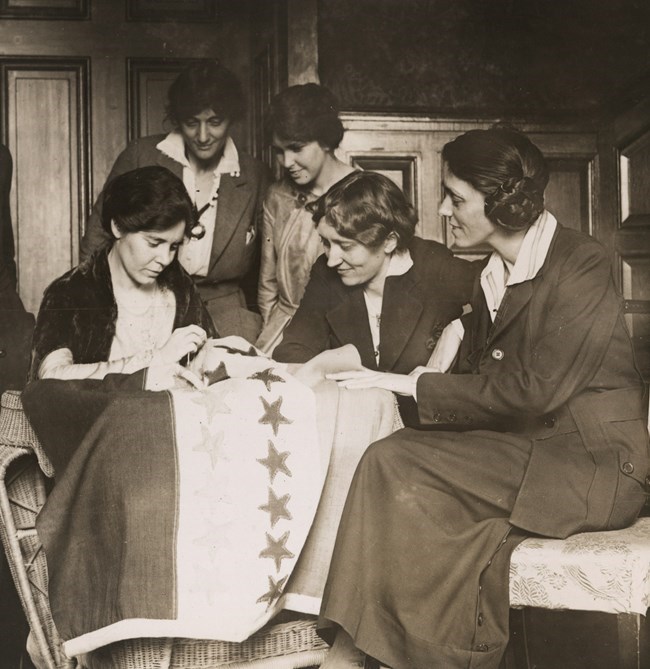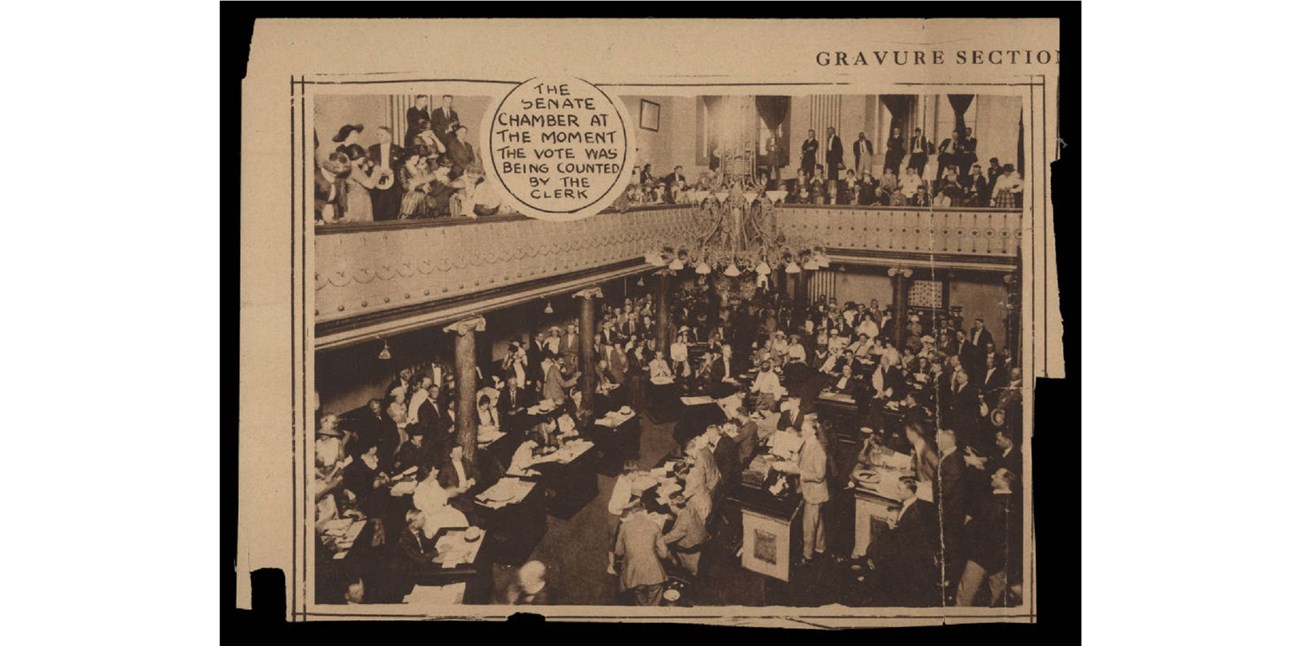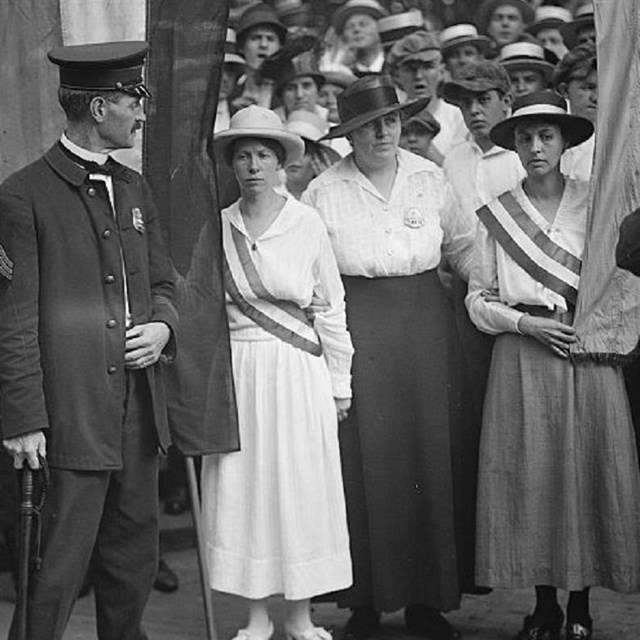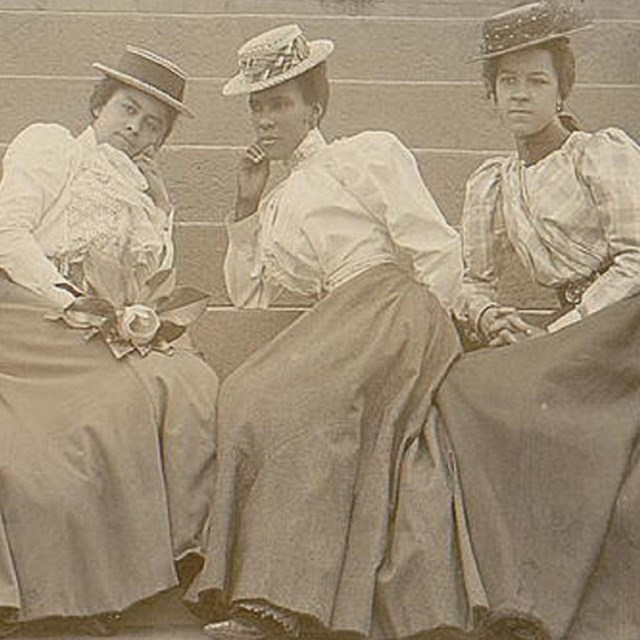Part of a series of articles titled Teaching Engaged Citizenship.
Article
(H)our History Lesson: Teaching Engaged Citizenship, Amending the U.S. Constitution

This lesson was written by Talia Brenner and edited by Katie McCarthy.
Grade Level:
This lesson is intended for middle school learners but can easily be adapted for use by learners of all ages.
Lesson Objectives:
Learners will be able to....
- Identify key steps in the process through which the Constitution is amended.
- Understand why people might want to amend the Constitution.
- Distinguish between fact, opinion, and reasoned judgement in arguments for proposed amendments.
Inquiry Question:
Take a moment to examine the photo below.
What is going on in this picture? What makes you say that? How does this picture help us understand how laws are changed in the United States?

Reading:
In the United States, laws change over time. When the United States was founded in the late 1700s, slavery was legal in most states. Children were not legally required to go to school, people were allowed to hurt their pets, and there were no laws regulating cars and phones because those technologies did not yet exist.
Changes to the law happen through a variety of processes. The U.S. Congress can change the law by repealing laws or passing new ones. The Supreme Court can change the law when they rule that existing laws are unconstitutional. For instance, a 2015 Supreme Court decision made same-sex marriage legal in states where it was previously against the law. Changes to the law can also happen through amendments, or changes, to the U.S. Constitution. The Constitution is the founding document of the United States. It is considered the “supreme law of the land,” which means that the government must follow it. The Constitution can only be changed through the amendment process.
Though laws frequently change through other methods, constitutional amendments are rare. In over 230 years, there have only been 27 amendments. There are a few reasons for this. First, amendments are usually only needed to change or clarify something that the Constitution specifically says. The Constitution is a short document. In most booklet versions, it is fewer than 20 pages long. It outlines the structure of the government, but does not include most of the laws that exist in the United States. Most of the time, changing a law does not require changing the Constitution.
Second, compared to other ways of changing laws, it is very difficult to amend the Constitution. For an amendment to be approved, two-thirds of both houses of Congress must pass the amendment. (An amendment can also pass with a two-thirds vote at a national convention, but this has never happened before). Then, three-fourths of all states must ratify the amendment, either in their statehouses or at a special convention. Many proposed amendments to the Constitution never reach ratification.
The Framers, the men who wrote the Constitution, wanted the amendment process to be difficult. They believed that a long and complicated amendment process would help create stability in the United States. Because it is so difficult to amend the Constitution, amendments are usually permanent. Once an amendment is ratified, it is considered part of the Constitution. Since the Constitution is the supreme law of the land, it cannot be changed by any process except for another amendment.
Amending the Constitution is the most difficult and permanent way of changing laws in the United States. It is also the most significant. At different points in U.S. history, activists have pushed for constitutional amendments as a way to create lasting change.
Discussion Questions:
-
What are some reasons that laws change over time?
-
Why would people who were trying to change a law advocate for a constitutional amendment instead of trying to change the law another way?
-
¾ of 50 is 37.5, but the number of states required to ratify a constitutional amendment is rounded up to 38, instead of rounded down to 37. Why do you think that is?
-
Why did the Framers want the process of amending the Constitution to be so difficult?
Activities:
Each of the following activities encourages learners to think critically about why individuals support amendments, which amendments succeed, and which fail. Educators are encouraged to choose one or more of these activities to complete with their participants.
Activity 1: Researching Proposed Amendments
Have participants, working either individually or in small groups, visit the U.S. Congress’ website at www.congress.gov. In the search bar, have students search "Amendment to the Constitution of the United States" to yield recently proposed amendments to the U.S. Constitution. Have students select a recently proposed amendment that interests them. Some of the search results will be proposed legislation that references a past amendment to the U.S. Constitution, not proposed amendments themselves, so ensure that learners select actual proposed amendments. You also might want to limit participants to legislation proposed during the current session of Congress, or within the last two sessions.
Have students complete the following investigation using the Internet:
-
Read the summary and then the full text of the bill (under the “summary” and “text” tabs). Using your own words, describe what the amendment would do.
-
Who is the member of Congress who sponsored of this proposed amendment? Is the sponsor in the Senate or the House of Representatives? What is this person’s party affiliation and home state?
-
Click on the “co-sponsors” tab to see which members of Congress are co-sponsoring the proposed amendment. If there are co-sponsors, are they all from the same political party as the sponsor?
-
Now, go to the website of the main sponsor (not an encyclopedia entry or a campaign website—the correct website will end in .gov). Browse through the issues that the member of Congress highlights on the website. Does the website mention the proposed amendment or any similar topics?
-
Using an internet search engine, find three reasons that people have given in support of this amendment. If you cannot find much media coverage about the specific amendment, you can research the policy that it proposes (for instance, setting the number of Supreme Court justices to 9 or making the federal government partially responsible for education). Be sure to use sources such as news articles, nonprofit organizations’ publications, and quotes and press releases from politicians.
After participants have completed the investigation activity, have students respond to the following question: “Do you think that the proposed amendment you studied should be part of the U.S. Constitution?” Learners could write a letter or email to their district’s U.S. representative or senator (based on whether the amendment they studied was proposed in the House of Representatives or in the Senate) expressing their opinion about the legislation. Students could also write opinion pieces for their school or local newspaper or create a graphic, listicle, or short video to convince other people to feel a certain way about the amendment.
Activity 2: Researching Unsuccessful Amendments
There are hundreds, if not thousands, of proposed amendments to the Constitution that never became law. But among these are a few that came very close. Divide students into small groups and have each group create its own diagram showing the process of amending the U.S. Constitution. Students should refer to the information provided in the reading. Students could create their diagrams either digitally or on paper.
Then, have each group research a constitutional amendment proposal in U.S. history that was ultimately unsuccessful. Possible amendments for students to research are:
-
The Titles of Nobility Amendment
-
The Flag Desecration Amendment (2006)
-
The District of Columbia Voting Rights Amendment
-
The Equal Rights Amendment
-
The Ludlow Amendment
-
The Balanced Budget Amendment (1995)
Please note that some more obscure unsuccessful amendments do not have much information available online. There is enough information available on credible websites for all the above amendment proposals. Additionally, please be aware that some amendments have been proposed multiple times. If students select one of those amendments, ensure that they are only researching one specific proposal.
Each group should research the answers to the following questions:
-
What year was this amendment first proposed in Congress?
-
In one or two sentences, summarize how this amendment would have changed the law.
-
Who supported this amendment? Why do you think they supported it?
-
How did this amendment fail? Return to your diagram and mark the “path” this unsuccessful amendment followed, including the step at which it was defeated.
Once students have completed their research, they could create formal or informal presentations to teach the class about the unsuccessful amendment they studied.
Activity 3: Debating the Amendment Process
Pose the question, “Is the amendment process too difficult?” Then have students debate the question in small groups, using examples from U.S. history to argue their side. If your class is split evenly in its responses to the question, you might divide students in a way that allows then to argue their own beliefs. Students could also argue assigned positions. An alternative activity would be for students to write opinion pieces for their school or local newspaper in response to the question, using examples from U.S. history in their writing.
Wrap-up:
-
Do you think the amendment process is too difficult?
-
How do you think our laws or government might be different if it were easier to amend the Constitution?
-
Why might amending the Constitution matter to you or the people around you, like your family?
Additional Resources:
National Archives
The National Archives’ website has primary sources and classroom activities available about topics relating to the U.S. Constitution. The website also features the full text of the Constitution and its amendments, in addition to photographs of U.S. founding documents.
Independence National Historic Park
Independence National Historic Park, located at Independence Hall in Philadelphia, has information about the Framers and the history of the site on its web page.
Amending the Constitution in History
-
 The Sewall-Belmont House
The Sewall-Belmont HouseLearn about how American women organized to increase their political rights in the 20th century.
-
 Lafayette Park
Lafayette ParkLearn how a group of determined women selected Lafayette Park, across from the White House, to demonstrate for their right to vote.
-
 Teaching the 19th Amendment
Teaching the 19th AmendmentExplore educational resources associated with the 19th Amendment and women’s suffrage.
Last updated: July 31, 2023
